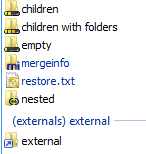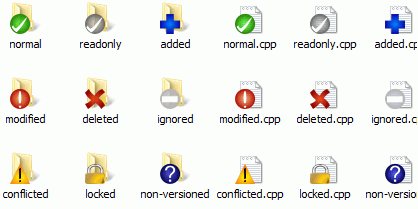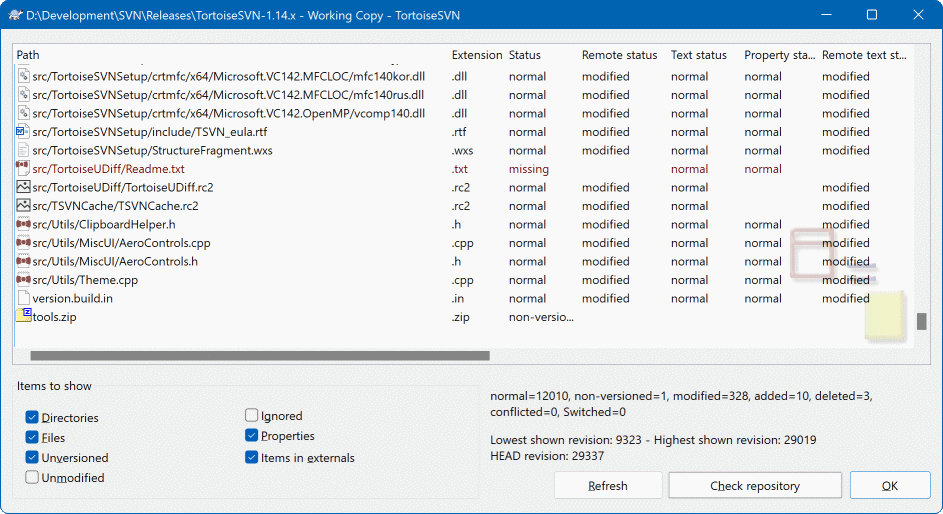While you are working on your working copy you often need to know which files you have changed/added/removed or renamed, or even which files got changed and committed by others.
Now that you have checked out a working copy from a Subversion repository you can see your files in the windows explorer with changed icons. This is one of the reasons why TortoiseSVN is so popular. TortoiseSVN adds a so called overlay icon to each file icon which overlaps the original file icon. Depending on the Subversion status of the file the overlay icon is different.
A fresh checked out working copy has a green checkmark as overlay. That means the Subversion status is normal.
As soon as you start editing a file, the status changes to modified and the icon overlay then changes to a red exclamation mark. That way you can easily see which files were changed since you last updated your working copy and need to be committed.
If during an update a conflict occurs then the icon changes to a yellow exclamation mark.
If you have set the svn:needs-lock property on a file,
Subversion makes that file read-only until you get a lock on that file.
Such files have this overlay to indicate that you have to get a lock
first before you can edit that file.
If you hold a lock on a file, and the Subversion status is normal, this icon overlay reminds you that you should release the lock if you are not using it to allow others to commit their changes to the file.
This icon shows you that some files or folders inside the current folder have been scheduled to be deleted from version control or a file under version control is missing in a folder.
The plus sign tells you that a file or folder has been scheduled to be added to version control.
The bar sign tells you that a file or folder is ignored for version control purposes. This overlay is optional.
This icon shows files and folders which are not under version control, but have not been ignored. This overlay is optional.
In fact, you may find that not all of these icons are used on your system. This is because the number of overlays allowed by Windows is very limited and if you are also using an old version of TortoiseCVS, then there are not enough overlay slots available. TortoiseSVN tries to be a “Good Citizen (TM)” and limits its use of overlays to give other apps a chance too.
Now that there are more Tortoise clients around (TortoiseCVS, TortoiseHg, ...) the icon limit becomes a real problem. To work around this, the TortoiseSVN project introduced a common shared icon set, loaded as a DLL, which can be used by all Tortoise clients. Check with your client provider to see if this has been integrated yet :-)
For a description of how icon overlays correspond to Subversion status and other technical details, read the section called “Icon Overlays”.
Sometimes you want to have more detailed information
about a file/directory than just the icon overlay.
You can get all the information Subversion provides in the
explorer properties dialog. Just select the file or
directory and select
→
in the context menu (note: this is the normal properties menu entry
the explorer provides, not the one in the TortoiseSVN submenu!).
In the properties dialog box TortoiseSVN has added a new
property page for files/folders under Subversion control,
where you can see all relevant information about the
selected file/directory.
It's often very useful to know which files you have
changed and also which files got changed and
committed by others. That's where the command
→
comes in handy.
This dialog will show you every file that has changed in any
way in your working copy, as well as any unversioned files
you may have.
If you click on the then you can also look for changes in the repository. That way you can check before an update if there's a possible conflict. You can also update selected files from the repository without updating the whole folder. By default, the button only fetches the remote status with the checkout depth of the working copy. If you want to see all files and folders in the repository, even those you have not checked out, then you have to hold down the Shift key when you click on the button.
The dialog uses colour coding to highlight the status.
- Blue
Locally modified items.
if unchanged files are inside a directory that's been moved, the status will show a
+sign in the status column, and it will be colored in blue as well.- Purple
Added items. Items which have been added with history have a
+sign in the Text status column, and a tooltip shows where the item was copied from.- Dark red
Deleted or missing items.
- Green
Items modified locally and in the repository. The changes will be merged on update. These may produce conflicts on update.
- Bright red
Items modified locally and deleted in repository, or modified in repository and deleted locally. These will produce conflicts on update.
- Black
Unchanged and unversioned items.
This is the default colour scheme, but you can customise those colours using the settings dialog. Read the section called “TortoiseSVN Colour Settings” for more information.
Overlay icons are used to indicate other states as well. The screenshot below shows all the possible overlays that are shown if necessary.

Overlays are shown for the following states:
Checkout depth
empty, meaning only the item itself.Checkout depth
files, meaning only the item itself and all file children without child folders.Checkout depth
immediates, meaning only the item itself and all file and folder children, but without children of the child folders.Nested items, i.e., working copies inside the working copy.
External items, i.e., all items that are added via an
svn:externalsproperty.Items that are restored after a commit. See the section called “Commit only parts of files” for details.
Items that have property modifications, but only to the
svn:mergeinfoproperty. If any other property is modified, the overlay is not used.
Items which have been switched to a different repository path are
also indicated using an (s) marker. You may have
switched something while working on a branch and forgotten to switch
back to trunk. This is your warning sign!
The context menu allows you to switch them back to the normal path again.
From the context menu of the dialog you can show a diff of the changes. Check the local changes you made using → . Check the changes in the repository made by others using → .
You can also revert changes in individual files. If you have deleted a file accidentally, it will show up as Missing and you can use Revert to recover it.
Unversioned and ignored files can be sent to the recycle bin from here using → . If you want to delete files permanently (bypassing the recycle bin) hold the Shift key while clicking on Delete.
If you want to examine a file in detail, you can drag it from here into another application such as a text editor or IDE, or you can save a copy simply by dragging it into a folder in explorer.
The columns are customizable. If you right click on any column header you will see a context menu allowing you to select which columns are displayed. You can also change column width by using the drag handle which appears when you move the mouse over a column boundary. These customizations are preserved, so you will see the same headings next time.
If you are working on several unrelated tasks at once, you can also group files together into changelists. Read the section called “Change Lists” for more information.
At the bottom of the dialog you can see a summary of the range of repository revisions in use in your working copy. These are the commit revisions, not the update revisions; they represent the range of revisions where these files were last committed, not the revisions to which they have been updated. Note that the revision range shown applies only to the items displayed, not to the entire working copy. If you want to see that information for the whole working copy you must check the Show unmodified files checkbox.
Tip
If you want a flat view of your working copy, i.e. showing all files and folders at every level of the folder hierarchy, then the Check for Modifications dialog is the easiest way to achieve that. Just check the Show unmodified files checkbox to show all files in your working copy.
Repairing External Renames
Sometimes files get renamed outside of Subversion, and they show up in the file list as a missing file and an unversioned file. To avoid losing the history you need to notify Subversion about the connection. Simply select both the old name (missing) and the new name (unversioned) and use → to pair the two files as a rename.
Repairing External Copies
If you made a copy of a file but forgot to use the Subversion command to do so, you can repair that copy so the new file doesn't lose its history. Simply select both the old name (normal or modified) and the new name (unversioned) and use → to pair the two files as a copy.
Often you want to look inside your files, to have a look at what
you've changed. You can accomplish this by selecting a file which
has changed, and selecting from
TortoiseSVN's context menu. This starts the external
diff-viewer, which will then compare the current file with the
pristine copy (BASE revision), which was stored
after the last checkout or update.
Tip
Even when not inside a working copy or when you have multiple versions of the file lying around, you can still display diffs:
Select the two files you want to compare in explorer (e.g. using Ctrl and the mouse) and choose from TortoiseSVN's context menu. The file clicked last (the one with the focus, i.e. the dotted rectangle) will be regarded as the later one.


